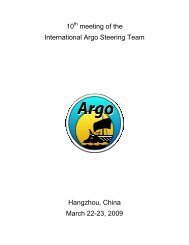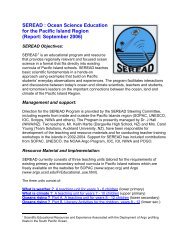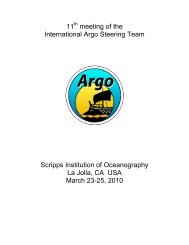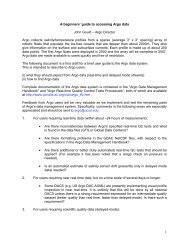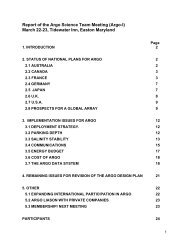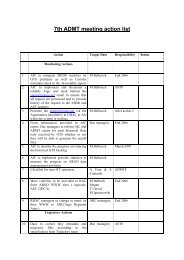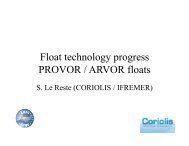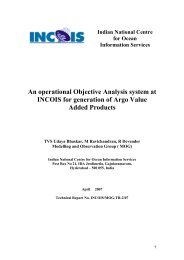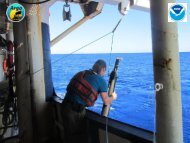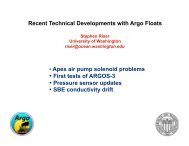AST-12 meeting report posted - Argo
AST-12 meeting report posted - Argo
AST-12 meeting report posted - Argo
Create successful ePaper yourself
Turn your PDF publications into a flip-book with our unique Google optimized e-Paper software.
A failure would mean the air bladder would not inflate, resulting in the possible loss of the ability<br />
to communicate with a satellite. This is especially problematic for Iridium floats. The problem<br />
can be corrected by adding a small, inexpensive, printed circuit board near the solenoid. This fix<br />
has been added to all UW and PMEL floats since February 2011. As of March 2011,<br />
Teledyne/Webb have not instituted the remedy and it is not clear whether or not they intend to<br />
add the auxiliary PCB in their production process. UW has developed a prototype float that<br />
uses a Kenwood PMT to communicate with ARGOS-3 satellites. The first tests of the Kenwood<br />
PMT have shown that energy use is larger than with present ARGOS-2 PTTs. Finally, both<br />
Jamstec and PMEL have noted APEX floats with unacceptable conductivity drift after<br />
deployment (> 0.01 PSU equivalent). The cause of the problem has been found and new QC<br />
procedures have been installed at SBE. It is believed that this problem occurred in an isolated<br />
group of floats (CTDs built in late 2010) but all groups should check for this.<br />
D. Roemmich presented an update on the SOLO-II which is now commercially available<br />
through MRV Systems (http://www.mrvsys.com). The SOLO-II is engineered to complete<br />
around 300 dives anywhere in the world ocean using Iridium. It weighs less and is shorter than<br />
the SOLO making it easier to deploy. Two SOLO-II prototypes have been deployed and<br />
completed many successful cycles. US production of the SOLO-II will be done by both SIO and<br />
MRV. 15 SOLO-II floats have been sent to Papeete for deployment along the equator with<br />
more than 150 floats to be built in 2011.<br />
Jon Turton outlined some results from preliminary analysis of data from eight Near<br />
Surface Temperature-capable (NST-capable) Apex floats deployed by UK. Although relatively<br />
few stratified profiles were observed, the results show the NST-capable Apex floats are able to<br />
observe near-surface temperature stratification that would otherwise remain undetected and so<br />
do provide useful additional information. More work is needed to further explore the NSTcapable<br />
floats.<br />
S. Wijffels <strong>report</strong>ed on work done by E. Van Wijk and others on the prospects for<br />
extending <strong>Argo</strong> into the seasonal and fast ice zone. Mortality rates of newer ice floats are now<br />
equivalent to those deployed in less demanding conditions, but the short surface time<br />
associated with Iridium is also a likely factor. A quick comparison among ice-float deploying<br />
groups shows a survival rate of around 80%. Extending <strong>Argo</strong> into the seasonal ice zone would<br />
require an additional ~600 floats. It was suggested that <strong>Argo</strong> continue to pilot ice-capable floats<br />
in order to refine the technology, but to also explore alternative sampling platforms.<br />
Demonstrating <strong>Argo</strong>’s value<br />
Dr Juliet Hermes presented the South African Environmental Observation Network<br />
education program, of which <strong>Argo</strong> floats form a key component. This program creates a platform<br />
where Marine Science Research can be integrated into School Sciences curriculum (with buy-in<br />
from the Department of Education). There are three main thrusts: educator/teacher support<br />
through workshops, school based monitoring programs and additional student support in<br />
Science Camp. Dr. Hermes also gave details of South African activities of interest to the <strong>Argo</strong><br />
community and highlighted that all South African marine institutes have potential to be more<br />
involved with <strong>Argo</strong> over the next five years. A new vessel is commissioned for 20<strong>12</strong> and there<br />
will be more float deployment opportunities aboard ASCLME cruises.<br />
M. Scanderbeg presented on the development of the Global Marine <strong>Argo</strong> Atlas which uses<br />
Ferret to create plots of gridded data. Currently, the PC version of the Atlas comes with the 4-D<br />
gridded <strong>Argo</strong> dataset made at Scripps Institution of Oceanography (Roemmich and Gilson,<br />
2009), the Reynolds SST dataset, and the AVISO dataset. It is possible to create map plots,<br />
section plots, time series, line drawings and a few simple products. Both postscript and jpg<br />
outputs are available for plots that are created using the Atlas. Both NetCDF and ASCII outputs<br />
are available containing the data used to create the plots. Besides giving a quick view of the<br />
3



